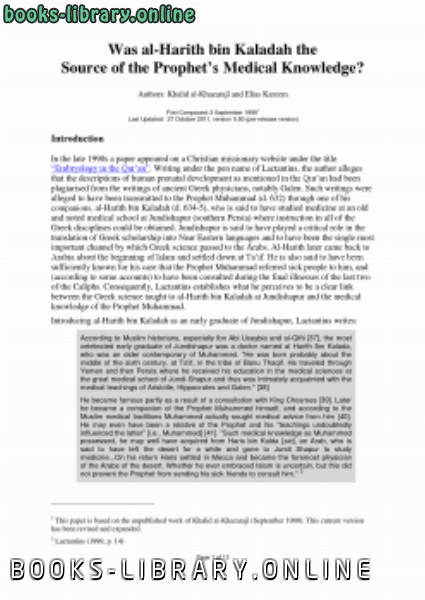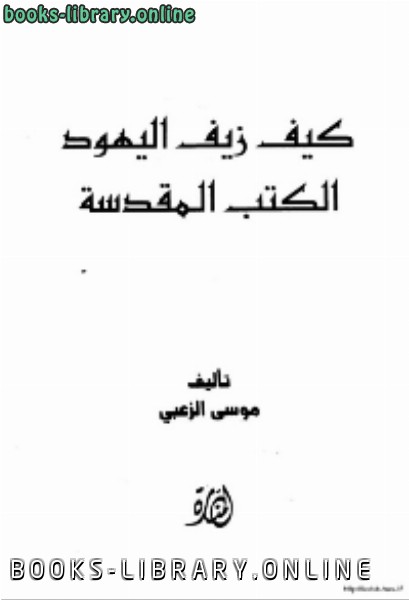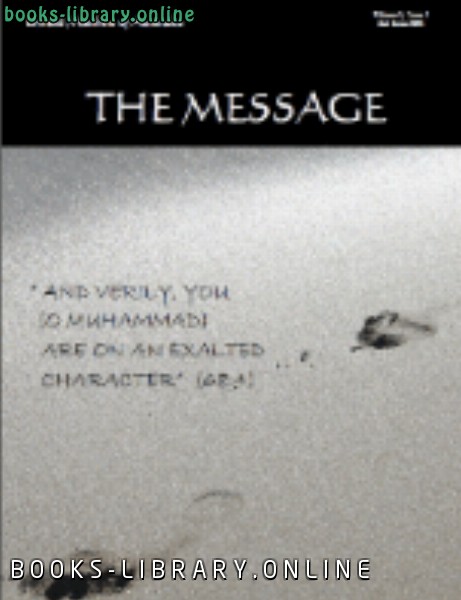كتاب Was al Harith bin Kaladah the Source of the Prophets Medical Knowledge
the late 1990s a paper appeared on a Christian missionary website under the title “Embryology in the Qur‟an”. Writing under the pen name of Lactantius, the author alleges that the descriptions of human prenatal development as mentioned in the Qur‟an had been plagiarised from the writings of ancient Greek physicians, notably Galen. Such writings were alleged to have been transmitted to the Prophet Muhammad (d. 632) through one of his companions, al-Harith bin Kaladah (d. 634-5), who is said to have studied medicine at an old and noted medical school at Jundishapur (southern Persia) where instruction in all of the Greek disciplines could be obtained. Jundishapur is said to have played a critical role in the translation of Greek scholarship into Near Eastern languages and to have been the single most important channel by which Greek science passed to the Arabs. Al-Harith later came back to Arabia about the beginning of Islam and settled down at Ta‟if. He is also said to have been sufficiently known for his care that the Prophet Muhammad referred sick people to him, and (according to some accounts) to have been consulted during the final illnesses of the last two of the Caliphs. Consequently, Lactantius establishes what he perceives to be a clear link between the Greek science taught to al-Harith bin Kaladah at Jundishapur and the medical knowledge of the Prophet Muhammad. Introducing al-Harith bin Kaladah as an early graduate of Jundishapur, Lactantius writes: According to Muslim historians, especially Ibn Abi Usaybia and al-Qifti [37], the most celebrated early graduate of Jundishapur was a doctor named al Harith Ibn Kalada, who was an older contemporary of Muhammed. "He was born probably about the middle of the sixth century, at Ta'if, in the tribe of Banu Thaqif. He traveled through Yemen and then Persia where he received his education in the medical sciences at the great medical school of Jundi-Shapur and thus was intimately acquainted with the medical teachings of Aristotle, Hippocrates and Galen." [38] He became famous partly as a result of a consultation with King Chosroes [39]. Later he became a companion of the Prophet Muhammed himself, and according to the Muslim medical traditions Muhammed actually sought medical advice from him [40]. He may even have been a relative of the Prophet and his "teachings undoubtedly influenced the latter" [i.e., Muhammed] [41]. "Such medical knowledge as Muhammed possessed, he may well have acquired from Haris bin Kalda [sic], an Arab, who is said to have left the desert for a while and gone to Jundi Shapur to study medicine...On his return Haris settled in Mecca and became the foremost physician of the Arabs of the desert. Whether he ever embraced Islam is uncertain, but this did not prevent the Prophet from sending his sick friends to consult him." 2 1 This paper is based on the unpublished work of Khalid al-Khazarajî (September 1999). This current version has been revised and expanded. 2 Lactantius (1999, p. 14)خالد الخزرجى - ❰ له مجموعة من الإنجازات والمؤلفات أبرزها ❞ Was al Harith bin Kaladah the Source of the Prophets Medical Knowledge ❝ ❱
من مقارنة الأديان فرق ومذاهب وأفكار وردود - مكتبة المكتبة التجريبية.

قراءة كتاب Was al Harith bin Kaladah the Source of the Prophets Medical Knowledge أونلاين
معلومات عن كتاب Was al Harith bin Kaladah the Source of the Prophets Medical Knowledge:
“Embryology in the Qur‟an”. Writing under the pen name of Lactantius, the author alleges
that the descriptions of human prenatal development as mentioned in the Qur‟an had been
plagiarised from the writings of ancient Greek physicians, notably Galen. Such writings were
alleged to have been transmitted to the Prophet Muhammad (d. 632) through one of his
companions, al-Harith bin Kaladah (d. 634-5), who is said to have studied medicine at an old
and noted medical school at Jundishapur (southern Persia) where instruction in all of the
Greek disciplines could be obtained. Jundishapur is said to have played a critical role in the
translation of Greek scholarship into Near Eastern languages and to have been the single most
important channel by which Greek science passed to the Arabs. Al-Harith later came back to
Arabia about the beginning of Islam and settled down at Ta‟if. He is also said to have been
sufficiently known for his care that the Prophet Muhammad referred sick people to him, and
(according to some accounts) to have been consulted during the final illnesses of the last two
of the Caliphs. Consequently, Lactantius establishes what he perceives to be a clear link
between the Greek science taught to al-Harith bin Kaladah at Jundishapur and the medical
knowledge of the Prophet Muhammad.
Introducing al-Harith bin Kaladah as an early graduate of Jundishapur, Lactantius writes:
According to Muslim historians, especially Ibn Abi Usaybia and al-Qifti [37], the most
celebrated early graduate of Jundishapur was a doctor named al Harith Ibn Kalada,
who was an older contemporary of Muhammed. "He was born probably about the
middle of the sixth century, at Ta'if, in the tribe of Banu Thaqif. He traveled through
Yemen and then Persia where he received his education in the medical sciences at
the great medical school of Jundi-Shapur and thus was intimately acquainted with the
medical teachings of Aristotle, Hippocrates and Galen." [38]
He became famous partly as a result of a consultation with King Chosroes [39]. Later
he became a companion of the Prophet Muhammed himself, and according to the
Muslim medical traditions Muhammed actually sought medical advice from him [40].
He may even have been a relative of the Prophet and his "teachings undoubtedly
influenced the latter" [i.e., Muhammed] [41]. "Such medical knowledge as Muhammed
possessed, he may well have acquired from Haris bin Kalda [sic], an Arab, who is
said to have left the desert for a while and gone to Jundi Shapur to study
medicine...On his return Haris settled in Mecca and became the foremost physician
of the Arabs of the desert. Whether he ever embraced Islam is uncertain, but this did
not prevent the Prophet from sending his sick friends to consult him." 2
1 This paper is based on the unpublished work of Khalid al-Khazarajî (September 1999). This current version
has been revised and expanded.
2 Lactantius (1999, p. 14)
للكاتب/المؤلف : خالد الخزرجى .
دار النشر : .
عدد مرات التحميل : 6423 مرّة / مرات.
تم اضافته في : الثلاثاء , 26 مارس 2019م.
حجم الكتاب عند التحميل : 455 كيلوبايت .
تعليقات ومناقشات حول الكتاب:
the late 1990s a paper appeared on a Christian missionary website under the title
“Embryology in the Qur‟an”. Writing under the pen name of Lactantius, the author alleges
that the descriptions of human prenatal development as mentioned in the Qur‟an had been
plagiarised from the writings of ancient Greek physicians, notably Galen. Such writings were
alleged to have been transmitted to the Prophet Muhammad (d. 632) through one of his
companions, al-Harith bin Kaladah (d. 634-5), who is said to have studied medicine at an old
and noted medical school at Jundishapur (southern Persia) where instruction in all of the
Greek disciplines could be obtained. Jundishapur is said to have played a critical role in the
translation of Greek scholarship into Near Eastern languages and to have been the single most
important channel by which Greek science passed to the Arabs. Al-Harith later came back to
Arabia about the beginning of Islam and settled down at Ta‟if. He is also said to have been
sufficiently known for his care that the Prophet Muhammad referred sick people to him, and
(according to some accounts) to have been consulted during the final illnesses of the last two
of the Caliphs. Consequently, Lactantius establishes what he perceives to be a clear link
between the Greek science taught to al-Harith bin Kaladah at Jundishapur and the medical
knowledge of the Prophet Muhammad.
Introducing al-Harith bin Kaladah as an early graduate of Jundishapur, Lactantius writes:
According to Muslim historians, especially Ibn Abi Usaybia and al-Qifti [37], the most
celebrated early graduate of Jundishapur was a doctor named al Harith Ibn Kalada,
who was an older contemporary of Muhammed. "He was born probably about the
middle of the sixth century, at Ta'if, in the tribe of Banu Thaqif. He traveled through
Yemen and then Persia where he received his education in the medical sciences at
the great medical school of Jundi-Shapur and thus was intimately acquainted with the
medical teachings of Aristotle, Hippocrates and Galen." [38]
He became famous partly as a result of a consultation with King Chosroes [39]. Later
he became a companion of the Prophet Muhammed himself, and according to the
Muslim medical traditions Muhammed actually sought medical advice from him [40].
He may even have been a relative of the Prophet and his "teachings undoubtedly
influenced the latter" [i.e., Muhammed] [41]. "Such medical knowledge as Muhammed
possessed, he may well have acquired from Haris bin Kalda [sic], an Arab, who is
said to have left the desert for a while and gone to Jundi Shapur to study
medicine...On his return Haris settled in Mecca and became the foremost physician
of the Arabs of the desert. Whether he ever embraced Islam is uncertain, but this did
not prevent the Prophet from sending his sick friends to consult him." 2
1 This paper is based on the unpublished work of Khalid al-Khazarajî (September 1999). This current version
has been revised and expanded.
2 Lactantius (1999, p. 14)
Page 2 of 12
Lactantius concludes:
So we have just the link we need to show how "The translations (into Syriac) of
Sergius Ras el Ain, penetrated to Jandi-Shapur. During the first years of the 7th
century [more likely the end of the sixth century], Harith ben Kalada studied medicine
there and Muhammad owed to Harith a part of his medical knowledge. Thus, with
the one as well as the other, we easily recognize the traces of Greek
(medicine)." [44] To summarise: Sergius died about the time that Chosroes the
Great began his reign, and may even have been employed by Chosroes to translate
Galen from Greek into Syriac. Halfway through his reign Chosroes founded
Jundishapur, where Galen's manuscripts must surely have been kept in translation.
Towards the end of his reign he had an audience with Harith Ibn Kalada, who later
became associated with Muhammed. 3
Was al-Harith the source of the Prophet‟s medical knowledge? Did al-Harith study at
Jundishapur? What type of medicine did al-Harith practice? We propose here to shed light on
the issues raised by Lactantius.
The Medical School of Jundishapur
It is generally believed that al-Harith was a graduate of the medical academy at Jundishapur
(southern Persia) but the existence of such an old and noted medical school connected with
Jundishapur has recently been called into question by a number of scholars. Lindberg in The
Beginnings of Western Science recounts the “often-repeated legend”:
An influential mythology has developed around Nestorian activity in the city of
Gondeshapur (often written ―Jundishapur‖) in south-western Persia. According to the
often-repeated legend, the Nestorians turned Gondeshapur into a major intellectual
center by the sixth century, establishing what some enthusiasts have chosen to call a
university, where instruction in all of the Greek disciplines could be obtained. It is
alleged that Gondeshapur had a medical school, with a curriculum based on
Alexandrian textbooks, and a hospital modeled on Byzantine hospitals, which kept the
realm supplied with physicians trained in Greek medicine. Of greatest importance,
Gondeshapur is held to have played a critical role in the translation of Greek
scholarship into Near Eastern languages and, indeed, to have been the single
most important channel by which Greek science passed to the Arabs.
Recent research has revealed a considerably less dramatic reality. We have no
persuasive evidence for the existence of a medical school or a hospital at
Gondeshapur, although, there seems to have been a theological school and perhaps
an attached infirmary. No doubt Gondeshapur was the scene of serious intellectual
endeavour and a certain amount of medical practice —it supplied a string of physicians
for the ̳Abbasid court at Baghdad beginning in the eighth century— but it is doubtful
that it ever became a major center of medical education or of translating activity. If the
story of Gondeshapur is unreliable in its details, the lesson it was meant to teach is
nonetheless valid.‖4
Porter, while acknowledging Jundishapur as an intellectual meeting place and crossroads for
scholars of various backgrounds, also casts doubt on whether a medical school actually
existed there. Porter in The Greatest Benefit to Mankind: A Medical History of Humanity
states:
It is often held that a distinctive Arab–Islamic medicine dates from the time of the
Prophet and stems from a hospital (bimaristan: Persian for house for the sick) and
academy at Jundishapur, near Susa in southern Persia. Jundishapur was certainly a
3 Lactantius (1999, p. 14)
4 Lindberg (1992, pp. 164-165).
Page 3 of 12
meeting-place for Arab, Greek, Syriac and Jewish intellectuals, but there is no
evidence that any medical academy existed there. Only in the early ninth century
did Arab–Islamic learned medicine take shape. The first phase of this revival lay in a
major translation movement, arising during the reign of Harun al-Rashid (r. 786-809)
and gaining impetus in the caliphate of his son, al-Ma‘mum (r. 813-33). It was
stimulated by a socioeconomic atmosphere favourable to the pursuit of scholarship, a
perceived need among both Muslims and Christians for access in Arabic to ancient
medicine, and the ready availability of the relevant texts.5
Regarding the presumed medical school of Jundishapur, Saliba states in his review of the
Encyclopaedia Iranica6
:
Before reviewing the entries dealing with medicine, I would like to make some general
remarks about the presumed medical school of Jundishapur, for the existence of this
school and the hospital that was supposed to have been attached to it, as well as the
academy in the same city, have all been repeated in the sources, and are referred to
more than once in this encyclopedia as well. Put briefly, the city of Jundishapur was
supposed to have been founded by the Sasanian king Shapur I (241-71), who settled it
with prisoners of war taken in his victory over Emperor Valerian. Later on, the same
Sasanian king is supposed to have married the daughter of the Roman emperor
Aurelian whose retinue was said to have included two Greek physicians, who in turn
were to introduce Greek medicine into the city. Shapur II (309-79) is reputed to have
enlarged the city and to have founded an academy. Some even go so far as to say that
he also founded an observatory, a hospital and a school of theology. Later on, Greek
philosophers escaping the wrath of Justinian after the closure of the Neoplatonic
academy in Athens in 529 were supposed to have migrated to Jundishapur and to have
brought with them Greek learning in all its forms. Throughout the pre- Islamic period the
city is thought to have become a meeting place for Greek and Indo/Persian learning
and continued to function as such well into the early Islamic centuries when it finally
made its decisive mark on the nascent Islamic civilization by exporting to the Abbasid
court, towards the middle of the eighth century, the most famous family of physicians to
have come out of that city, namely the BOḴTĪŠŪʿ. From then on the city, with all its
institutions, is supposed to have fallen into oblivion and nothing is heard about it
thereafter, except in geographers' reports bemoaning its demise.
This story, despite its widespread currency in medieval and modern sources, is
essentially ahistorical. The reports regarding the institutions affiliated with this city —
the school, the hospital, and the academy— despite their frequency in later medieval
sources, are unique to the city of Jundishapur. It is in this context that I would like to
raise the following cautionary remarks. First, it is quite unlikely that Jundishapur would
be the only city in the Sasanian or Byzantine empires to maintain a school and a
hospital, let alone an academy, for hundreds of years. Second, all the references to the
hospital in that city and to the academy/school are of such late dates that their
credibility cannot be accepted without a much more critical assessment. Third, if there
were such a school/academy and a hospital at Jundishapur, and if all these institutions
were a carry-over from late antiquity as legend maintains, why then didn't they make
their mark during the first hundred years of Islam, and only began to exert an influence
during the early part of the Abbasid reign? It is impossible to believe that such cultural
institutions could be restricted for almost a century during Islamic times and many more
prior centuries in the Sasanian period and only then emerge to exert their influence on
other cities and other institutions. It is simply not credible. Fourth, the mere association
of Mani7 with the hospital or academy in that city, as reported by Firdawsi, is, in the
opinion of this author more fiction than reality, and little should be made of it in terms of
confirming the existence of such a hospital or the lack thereof. Finally, the main
features of the legend sound very much like an attempt to try to explain the
5
Porter (1997, p. 94).
6
Shahbazi and Richter-Bernburg (2002).
7 Mani was a religious preacher and the founder of Manichaeism. Born in western Persia (approximately 210-
275 CE).
Page 4 of 12
motivation for the transfer of science from Hellenistic civilization to the world of
Islam, and to pinpoint the means by which this transfer took place. We should
recall here that the Syrian city of Harran, with its own wealth of stories regarding star-
worshipping pagans and the like, plays a similar role in the historiography of science
and is also a late attempt to explain the route and means by which Greek science was
incorporated by Islam.
This does not mean that there were no institutions to care for the sick and the poor in
pre-Islamic Persia or during early Islamic times. But the doubts I am raising concern the
nature of such institutions. The most likely story is that the later institution of the
BĪMĀRESTĀN, as it developed mainly in Baghdad during Abbasid times, was a novel
idea that may have only been inspired by similar practices that had taken place in
previous times both in Iran and in the Byzantine empire and itself was not a natural
progression from those institutions. Finally, much more research needs to be done
regarding the intellectual legacy of Jundishapur before it can be used as a
source for later intellectual or institutional legacies.8
It is evident that the history and the importance of Jundishapur as a medical centre is
uncertain. Prioreschi in A History of Medicine points out that there are no Persian sources that
support the claim that Jundishapur played such an important role in the history of medicine. 9
In fact specific mention of Jundishapur does not seem to occur until Ibn Qifti (d. 1248)
10 ; the
legend of Jundishapur appears to have been based on the statement of Bar Hebraeus (d.
1286):
It would appear that the legend of Jundishapur is based on the thirteenth century
testimony of Barhebraeus, who states that a Roman emperor sent eminent Greek
physicians to Persia in the retinue of his daughter, who was to marry Shapur I11
.
Although Barhebraeus himself does not mention a school, it was added later that the
physicians then established a school in newly-built Jundishapur.
On the other hand, Jundishapur, as mentioned above, seems to have achieved
considerable reputation as a medical school by the end of the Umayyad caliphate (661-
750). This is shown by the story reported by al-Jahiz (c. 840) about a starving Muslim
physician in early ninth-century Baghdad who had no patients because, as al-Jahiz
explains, he was not a clearly recognizable physician from Jundishapur: he had a non-
Christian name, he wore a white cotton cloak instead of black silk and he did not speak
the language of Jundishapur. These facts, however, tell us nothing about its academic
history, nor do they tell us what the Arabs found there, that is to say, what kind of
school and what kind of hospital.
It seems, in fact, that in the sixth century, there was a (Nestorian) medical school in
Jundishapur, even if the date of its origin and its role in the transmission of medical
knowledge to the Arab world are not what they sometimes have been assumed to be.
For the evidence for the school's early years, our best source is perhaps the
continuator of Zacharias Rhetor‘s ―Ecclesiastical History,‖ who cannot have written very
long after the events he describes. The author states that, on the advice of Christian
doctors at his court, and ―because of his compassion towards Christian captives and
the chaste ones,‖ Chosroes I (regnabat 531-579) built a hospital and provided it with
twelve doctors. There is no reference to a pre-existing Nestorian hospital, or to a
medical school other than Nisibis (from which one of the court physicians had come).
 مهلاً !
مهلاً !قبل تحميل الكتاب .. يجب ان يتوفر لديكم برنامج تشغيل وقراءة ملفات pdf
يمكن تحميلة من هنا 'تحميل البرنامج'

نوع الكتاب : pdf.
اذا اعجبك الكتاب فضلاً اضغط على أعجبني و يمكنك تحميله من هنا:


كتب اخرى في مقارنة الأديان

Jesus and Christianity In the Perspective of Islam PDF
قراءة و تحميل كتاب Jesus and Christianity In the Perspective of Islam PDF مجانا

Muhammad pbuh Foretold in the Bible by Name PDF
قراءة و تحميل كتاب Muhammad pbuh Foretold in the Bible by Name PDF مجانا






